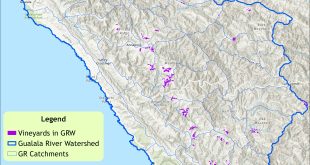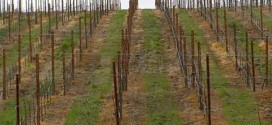The original intent of the ordinance – and the public outpouring of support – has been to put protections in place to preserve the remaining timberlands and watersheds of Sonoma County from conversion and the environmental impacts posed by this deforestation. However, the version now under consideration totally misses the mark of this intent.
Update: February 7, 2006
At the February 7th meeting of the Sonoma County Board of Supervisors, the proposed ordinance to protect county forests from conversion was the main subject. The ordinance language was altered slightly by two additions suggested by the Planning Commission. A straw vote was held with the result being a 4 to 1 approval. A final vote will be supposedly taken on March 14th.
At the end of the meeting discussion, a request was made by Supervisor Reilly to county staff (PRMD) to generate language for a provision for the ordinance that would require that the lands used in the 2 (preserved) for 1 (converted) trading requirement include the need that the traded land have slope requirements. Some of the ideas presented were: Less than 50%, levels mentioned in the Vineyard Erosion Control Ordinance, and that the slopes have the same average as the converted land.
Due to the fact that the present ordinance language allows for a net loss of forestland and does not mitigate loss of the converted land with similar land that is also under threat of future conversion, additional requirements are needed to make this ordinance have any real impact on the conversion threat. With the present language most project proponents with modest financing will be able to trade steep untillable land and additionally qualify for a finding of public benefit under the generous guidelines.
FoGR:
|
Discussion
We are fortunate to live in a county with a good balance of city, agriculture, and forest; we need to protect that diversity. We don’t want the whole county to be paved or plowed, and so we need to protect Sonoma’s remaining forestland.
Among recent issues before the public in Sonoma County, few have raised more concern than the threat to forests and natural lands by vineyard conversions in the forested Northern County (see: “Nature in a Bottle” – published in the Spring 2005 issue of California Wild, the magazine of the California Academy of Sciences). Central to that issue has been a two year effort to update the County’s General Plan to prevent loss of the 194,000 acres of forests in the Resource and Rural Development (RRD) land use category.

Vineyard conversion near Annapolis
Actually, every permit issued would result in a net loss of forest acreage, “mitigated” by a promise to protect some other acres of forest. A developer who owns 300 acres of forestland could promise to protect 200 acres in return for a permit to destroy 100 acres of forest to plant grapes. That is not “no net loss;” it is a permanent net loss of 100 acres.
Based on the recommendation of the Citizens’ Advisory Committee (CAC) and the overwhelming support of the citizens of Sonoma County who have commented on the issue, the General Plan update should provide strong protection for the remaining forests in the County. “Option 3,” which was recommended by the CAC, would provide that protection.
The new ordinance language would put the forests at even more risk than they in now. Rather than preventing large-scale conversions of forest to vineyards, the proposed “no net loss” provision would actually facilitate forest destruction.
- Grapes shouldn’t replace trees
– Sierra Club Sonoma Group - What’s Wrong with “No Net Loss”?
– Sierra Club Sonoma Group - Option 3 Rewrite No Longer Protects Forests
– Russian River Residents Against Unsafe Logging
Background
Sonoma County is updating its General Plan. One of the sections (elements) of the Plan is the Forestry Element. A key section of that proposed element deals with the conversion of forest lands to agricultural use.
At the moment, the economically attractive agricultural use is for vineyards. The County planning staff provided the Citizens’ Advisory Committee (CAC) on the Sonoma County General Plan with four options for the language relating to such conversions. In July, 2003 the CAC voted to support “option 3,” which provided the most protection for our forests.
Since then the planning department has drafted three additional options. “Option 5” would permit the destruction and fragmentation of our remaining forests. “Option 7” would ban conversions altogether. The planning department considers “Option 6” beyond their budgetary resources.
Press articles on forest conversions
- Timber regulations go to Sonoma Co. Supes
1/27/06, Independent Coast ObserverSonoma County has moved closer to regulating conversion of timberland to vineyards. A county use permit would be required in addition to existing state forestry permits.
- Environmentalists Fight Vineyards’ Spread
1/21/06, Associated Press“There are plenty of places to plant grapes in Sonoma County without cutting down redwood forests,” said Supervisor Mike Reilly, who advocates more restrictions…
- Sonoma Supes wrestle forest conversions
10/07/05, Independent Coast ObserverSonoma County Supervisors on Tuesday continued their struggle to regulate loss of forests to vineyards. The regulatory path the Supervisors must tread is narrow and winding, with court cases on every side.
- County’s vineyard vs. forest debate escalates
8/21/05, Santa Rosa Press DemocratA proposal to place greater restrictions on conversion of forests to vineyards is being called the most-watched issue to come before Sonoma County officials in almost a decade.
- Sonoma Supes hold hearing on conversions
8/19/05, Independent Coast ObserverSonoma County’s two-year debate about whether to regulate forestland conversions – usually done to plant pinot noir vineyards – will reach a high point at a Board of Supervisors hearing Tuesday evening.
- Evans Ridge is a complex vineyard project
8/12/05, Independent Coast ObserverCoastal residents were stunned in 1999 by a proposal by vineyard developer William Hill for 10,000 acres of grapes on local ridges. Last week the first project on Hill’s Preservation Ranch in Annapolis was unveiled.
- Sonoma studies vineyard conversions
4/29/05, Independent Coast ObserverSonoma County is pondering ways to regulate the conversion of redwood and Douglas fir forests to vineyards.
- Sonoma County Panel nixes logging setbacks
7/25/03, Independent Coast ObserverThe CAC accepted some changes to the language for timber conversions and sent it back to county counsel for more work.
- Sonoma County mulls timberland conversions
7/04/03, Independent Coast ObserverReviews the arguments for and against Option 3 made at the June 19 CAC Meeting.
- Sweeping proposal favors forest over vines
7/21/03, Santa Rosa Press DemocratFront page overview of the issue, with quotes from Somona County Supervisor Mike Reilly, the Farm Bureau, the Sonoma County Grapegrowers Association, the Sierra Club, and residents in the Annapolis area, both pro & con.
- Plan calls for 10,000 acres of grapes
5/22/99, Santa Rosa Press DemocratDescribes an early version of the still extant, but scaled back, proposal to convert thousands of acres of the upper Gualala River watershed to vineyards.
Letters regarding forest conversion, from:
- Friends of the Gualala River 9/28/05
County permit process for conversions should be a discretionary permit system rather than ministerial regulatory program. - a broad coalition of groups
Signed by organizations and individuals representing diverse interests throughout Sonoma County, recommending Option 3. - Coastal Forest Alliance
Provides a detailed analysis of all four options and rationale for favoring Option 3. - Russian River Residents Against Unsafe Logging
- Sierra Club, Sonoma Group
Other websites
with information about forest conversions
- Timber section of the Sonoma County website
- Redwood Chapter Sierra Club: Sonoma Group
- Russian River Residents Against Unsafe Logging
- Redwoods Forever
- Town Hall Coalition
Provides additional links to source documents. - Integrated Hardwood Range Management Program
Describes some of the effects of conversion of Oak Woodlands.
 Friends of Gualala River Protecting the Gualala River watershed and the species living within it
Friends of Gualala River Protecting the Gualala River watershed and the species living within it


